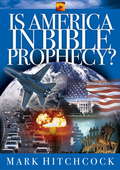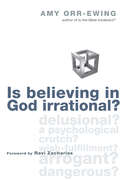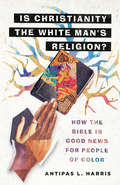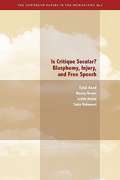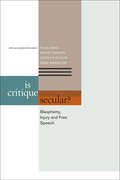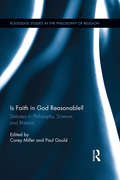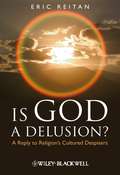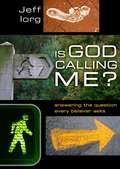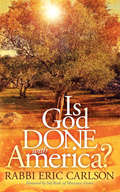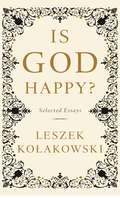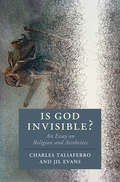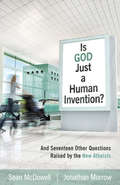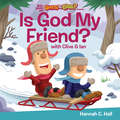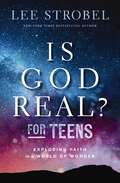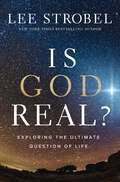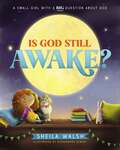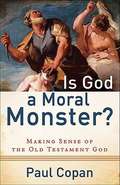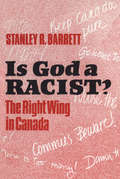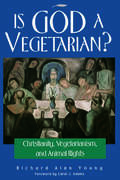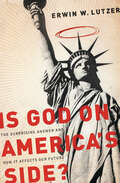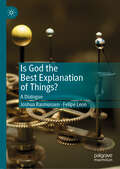- Table View
- List View
Is America in Bible Prophecy?
by Mark HitchcockProphecy expert Mark Hitchcock deals with often-raised questions about America's future in this thoroughly researched, reader-friendly resource. Examining three prophetic passages that are commonly thought to describe America, Hitchcock concludes that the Bible is actually silent about the role of the United States in the End Times. He then discusses the implications of America's absence in prophetic writings. Along with Hitchcock's compelling forecast for the future, he offers specific actions Americans can take to keep their nation strong and blessed by God, as well as an appendix of additional questions and answers. From the Trade Paperback edition.
Is Atheism Dead?
by Eric MetaxasIs Atheism Dead? is an entertaining, impressively wide-ranging, and decidedly provocative answer to that famous 1966 TIME cover that itself provocatively asked &“Is God Dead?&” In a voice that is by turns witty, muscular, and poetic, Metaxas intentionally echoes C.S. Lewis and G.K. Chesterton in cheerfully and logically making his astonishing case, along the way presenting breathtaking—and often withering—new evidence and arguments against the idea of a Creatorless universe. Taken all together, he shows atheism not merely to be implausible and intellectually sloppy, but now demonstrably ridiculous. Perhaps the only unanswered question on the subject is why we couldn&’t see this sooner, and how embarrassed we should be about it.
Is Christianity Good for the World?
by Douglas Wilson Christopher HitchensThe gloves come off in this electric exchange, originally hosted by Christianity Today, as leading atheist Christopher Hitchens (author of God Is Not Great) and Christian apologist Douglas Wilson (author of Letter from a Christian Citizen) go head-to-head on this divisive question. The result is entertaining and provocative a glimpse into the ongoing debate.
Is Christianity the White Man's Religion?: How the Bible Is Good News for People of Color
by Antipas L. HarrisAmong many young people of color, there is a growing wariness about organized religion and Christianity in particular.Is Christianity the White Man's Religion?
Is Critique Secular? Blasphemy, Injury and Free Speech
by Judith Butler Talal Asad Wendy Brown Saba MahmoodFour leading thinkers of our times confront the paradoxes and dilemmas attending the supposed stand-off between Islam and liberal democratic values. Authors inquire into the evaluative frameworks at stake in understanding the conflicts between blasphemy and free speech, between religious taboos and freedoms of thought and expression.
Is Critique Secular?: Blasphemy, Injury, and Free Speech
by Judith Butler Talal Asad Wendy Brown Saba MahmoodThis volume interrogates settled ways of thinking about the seemingly interminable conflict between religious and secular values in our world today. What are the assumptions and resources internal to secular conceptions of critique that help or hinder our understanding of one of the most pressing conflicts of our times?Taking as their point of departure the question of whether critique belongs exclusively to forms of liberal democracy that define themselves in opposition to religion, these authors consider the case of the “Danish cartoon controversy” of 2005. They offer accounts of reading, understanding, and critique for offering a way to rethink conventional oppositions between free speech and religious belief, judgment and violence, reason and prejudice, rationality and embodied life. The book, first published in 2009, has been updated for the present edition with a new Preface by the authors.
Is Everyone Happier Than Me?: An Honest Guide to the Questions That Keep You Up at Night
by Sarah BraggThe point where you feel like your life is unraveling can actually be a place of unimaginable growth--an awakening--if you're willing to ask yourself a few simple questions.In an age where everyone else's successes are flaunted in front of you on social media, it can be a struggle to feel true happiness and contentment exactly where you are. Throw in difficult circumstances--loss, heartbreak, change, midlife--and it's easy to understand why you feel lonely, lost, unsure of yourself, stuck, and, if you're honest with yourself, flat-out unhappy.Is Everyone Happier Than Me? provides practical and relatable answers to the questions you've probably already been asking about your life, and poses a few more, to help you figure out what's standing in the way of your happiness, peace, and connection. Author, podcaster, and midlife mom Sarah Bragg is a trustworthy comrade for the journey as she shares the valuable lessons she's learned in her own hard seasons to help you:Identify the unhealthy habits you do when you feel unhappy and how to overcome themDiscover simple ways to find peace even in the murky middle of hard seasonsFind new ways to connect with others and yourselfEmbrace exactly where you are even as you try to move forward It's time to let go of the ideal of a perfect life and allow yourself to be a work in progress. And there's no better time to find happiness than right here in the middle.
Is Faith in God Reasonable?: Debates in Philosophy, Science, and Rhetoric (Routledge Studies in the Philosophy of Religion)
by Corey Miller Paul GouldThe question of whether faith in God is reasonable is of renewed interest in today’s academy. In light of this interest, as well as the rise of militant religion and terrorism and the emergent reaction by neo-atheism, this volume considers this important question from the views of contemporary scientists, philosophers, and in a more novel fashion, of rhetoricians. It is comprised of a public debate between William Lane Craig, supporting the position that faith in God is reasonable and Alex Rosenberg, arguing against that position. Scholars in the aforementioned fields then respond to the debate, representing both theistic and atheistic positions. The book concludes with rejoinders from Craig and Rosenberg.
Is God A Delusion?: A Reply to Religion's Cultured Despisers
by Eric ReitanIs God a Delusion? addresses the philosophical underpinnings of the recent proliferation of popular books attacking religious beliefs. Winner of CHOICE 2009 Outstanding Academic Title Award Focuses primarily on charges leveled by recent critics that belief in God is irrational and that its nature ferments violence Balances philosophical rigor and scholarly care with an engaging, accessible style Offers a direct response to the crop of recent anti-religion bestsellers currently generating considerable public discussion
Is God Calling Me? Answering The Question Every Believer Asks
by Jeff IorgIs God calling me? It's the foundational question that must be answered by anyone considering entry into ministry leadership and then revisited regularly over a lifetime. Writing to a student and young adult audience -although applicable to leaders of all ages -Iorg declares the purpose of his brief, yet powerful book: "God is calling out a new generation of kingdom leaders who will accelerate the fulfillment of the Great Commission in this generation. My goal is to cut to the heart of the matter and give you tools to work through the call process. "
Is God Done with America?
by Rabbi Eric CarlsonFrom the founder of a messianic congregation: A powerful call to fulfill America&’s destiny by breaking down the barriers between Jews and Gentiles. America, drifting away from God and in a grave moral crisis, stands at a major spiritual crossroads. The truth of how this nation was founded and what its founders believed is being suppressed. Is America a Christian nation? Were America's founders Christians? Does America have a prophetic destiny? If so, will America fulfill that destiny? These questions and more are answered by Rabbi Eric Carlson in Is God Done with America? Based upon the &“One New Man&” of Ephesians 2:15, America&’s spiritual DNA was established through a prayer spoken by the founding colonists of the Jamestown Settlement in Virginia—the birthplace and spiritual root of America. A portion of this prayer, exactly as it was written and quoted from the book Lawes Divine, Morall and Martiall for the Colony of Virginea, printed in the year 1612, was spoken twice daily: &“And call in the Jewes together with the fulnesse of the gentiles, that thy name may be glorious in al the world, the dayes of iniquity may come to an end, and we with all thine elect people may come to see thy face in glorie, and be filled with the light thereof for evermore.&” This prayer not only reveals a portion of Americas prophetic destiny, it is key to the restoration of contemporary America&’s dying church. Is God Done with America? contains critical information regarding Jewish revival, the restoration of signs and wonders to the body of Messiah, and the reconciliation of Messianic Jews and Christians into one unified body.
Is God Happy?: Selected Essays
by Leszek Ko AkowskiThe late Leszek Kolakowski was one of the most influential philosophers of the twentieth century. A prominent anticommunist writer, Kolakowski was also a deeply humanistic thinker, and his meditations on society, religion, morality, and culture stand alongside his political writings as commentaries on intellectual--and everyday--life in the twentieth century. Kolakowski’s extraordinary empathy, humor, and erudition are on full display in Is God Happy?, the first collection of his work to be published since his death in 2009. Accessible and wide ranging, these essays--many of them translated into English for the first time--testify to the remarkable scope of Kolakowski’s work. From a provocative and deeply felt critique of Marxist ideology to the witty and self-effacing "In Praise of Unpunctuality” to a rigorous analysis of Erasmus’ model of Christianity and the future of religion, these essays distill Kolakowski’s lifelong engagement with the eternal problems of philosophy and some of the most vital questions of our age.
Is God Invisible?: An Essay on Religion and Aesthetics (Cambridge Studies in Religion, Philosophy, and Society)
by Charles Taliaferro Jil EvansIn this volume, Charles Taliaferro and Jil Evans promote aesthetic personalism by examining three domains of aesthetics - the philosophy of beauty, aesthetic experience, and philosophy of art - through the lens of Judaism, Christianity, Islam, theistic Hinduism, and the all-seeing Compassionate Buddha. These religious traditions assume an inclusive, overarching God's eye, or ideal point of view, that can create an emancipatory appreciation of beauty and goodness. This appreciation also recognizes the reality and value of the aesthetic experience of persons and deepens the experience of art works. The authors also explore and contrast the invisibility of persons and God. The belief that God or the sacred is invisible does not mean God or the sacred cannot be experienced through visual and other sensory or unique modes. Conversely, the assumption that human persons are thoroughly visible, or observable in all respects, ignores how racism and other forms of bias render persons invisible to others.
Is God Just a Human Invention?: And Seventeen Other Questions Raised by the New Atheists
by Sean Mcdowell Jonathan MorrowAtheism is making a comeback. From bookstores to bus campaigns, the question of God is up for public debate--and well-known atheists like Richard Dawkins and Christopher Hitchens are leading the charge. While these authors, who have been dubbed "The New Atheists," argue against religion in general, they aim most of their criticisms and complaints at the world's largest religion--Christianity. Why are people reading books that bash God and ridicule faith? And how can Christians respond?The writings of the New Atheists are especially challenging to the emerging generation who are skeptical of authority and have not been given answers to the hows and whys of faith's honest questions. For these readers especially, authors Sean McDowell and Jonathan Morrow have penned an accessible yet rigorous look at the arguments of the New Atheists. Writing from a distinctively Christian perspective, McDowell and Morrow lay out the facts so that the emerging generation can make up their own mind after considering all the evidence. Divided into two parts--the first addressing the scientific and philosophical challenges to belief in God and the second dealing with the moral and biblical challenges--Is God Just a Human Invention? will respond to each major argument in a way that is balanced, thorough, and easy to understand.McDowell and Morrow believe that the current religious landscape is both an opportunity and a challenge for people of faith.Now is the time to respond.
Is God My Friend?
by Hannah C. HallFeaturing beloved characters Clive & Ian from the bestselling video series What's in the Bible?, IS GOD MY FRIEND? weaves the biblical truth that God is a friend into a fun story with delightful illustrations, teaching little learners that they can be close with God. "God does kind things for us because He is our friend."Clive and Ian are playing in the snow! Ian thanks God for the fun (but cold!) gift. Clive helps his little brother Ian discover why God does such nice things for them (like giving them snow for snowball fights!), and they share neat ideas for how they can grow even closer to God, their special friend.
Is God Real? for Teens: Exploring Faith in a World of Wonder
by Lee StrobelDrawing on decades of research found in his Case for . . . series, as well as new interviews and insights, investigative journalist and former atheist Lee Strobel presents clear and compelling evidence to help seekers and believers answer life's ultimate question: Is God Real?Lee Strobel, weaves together the latest evidence from a range of brilliant scientific and philosophical minds to answer the most consequential question of all time. Is God Real? Teen Edition is tailored specifically for young minds. This engaging book unpacks evidence for God&’s existence with relatable stories, clear answers, and thought-provoking insights.From science and history to personal faith journeys, Strobel guides teens through doubts and skepticism to discover the truth about God. Perfect for parents and grandparents seeking to spark meaningful conversations, this book empowers teens to build a strong, evidence-based faith that stands firm in today&’s world. Equip your teen with the confidence to know: God is real, and He&’s closer than they think.
Is God Real?: Exploring the Ultimate Question of Life
by Lee StrobelIt's no coincidence that one of the most asked questions on any search engine is: "Is God real?"When life feels overwhelming, we want to know if there really is a deity who loves us, knows us, and cares about what happens to us. Join investigative journalist and former atheist Lee Strobel on a quest to determine whether we can know with confidence that God is real.Lee Strobel's landmark book, The Case for Christ, is one of the most respected defenses of Christianity of all time. Now in Is God Real? Lee weaves together material from his previous books with the latest evidence from the most brilliant scientific and philosophical minds to answer the pressing questions on our hearts and minds.In this rational exploration of the proof of God's existence, Lee investigates:If God is real, why is there so much suffering?How do we know which God is real?If God is real, why does he seem so hidden?How do recent scientific findings support the claim that God is real?If God is real, what difference does it make? Written for skeptics and believers alike, Is God Real? is a life-changing exploration of the question that matters most.
Is God Still Awake?: A Small Girl with a Big Question About God
by Sheila WalshIn this delightful full-color picture book that teaches children about prayer, bestselling author Sheila Walsh helps you show your kids how, when, and why to talk with God as they learn more of who God is and how much He loves them!Inspired by the ways God has used her book Praying Women, Sheila Walsh wanted to share her passion for prayer with kids--a passion that began when she was a little girl who wondered if God could hear her any time of the day or night.Is God Still Awake? introduces curious young readers to Poppy: a little girl who has big questions about God! Poppy wants to know how to talk with God and whether God listens to her. As she goes through her day with her cat by her side, Poppy discovers that God is always there--even when the world is asleep!With humorous, rhyming text, Is God Still Awake? assures children that God loves them and is always with them. Whether it's day or night, God is awake, He's listening, and He loves to hear His children speak!This whimsical jacketed picture book is a perfect gift for:children ages 4 to 8Christmas, baptisms, birthdayschildren beginning their faith journeygrandparents to share their faith across the milestraveling, snuggling, or bedtime reading
Is God a Moral Monster?: Making Sense of the Old Testament God
by Paul CopanA recent string of popular-level books written by the New Atheists have leveled the accusation that the God of the Old Testament is nothing but a bully, a murderer, and a cosmic child abuser. This viewpoint is even making inroads into the church. How are Christians to respond to such accusations? And how are we to reconcile the seemingly disconnected natures of God portrayed in the two testaments? In this timely and readable book, apologist Paul Copan takes on some of the most vexing accusations of our time, including: God is arrogant and jealous God punishes people too harshly God is guilty of ethnic cleansing God oppresses women God endorses slavery Christianity causes violence and more Copan not only answers God's critics, he also shows how to read both the Old and New Testaments faithfully, seeing an unchanging, righteous, and loving God in both.
Is God a Racist? The Right Wing in Canada
by Stanley R. Barrett‘God is a racist’—so goes a statement published in the literature of the Western Guard, a white-supremacist, anti-semitic group in Toronto. It is one of a number of racist organizations that have sprung up in Canada since the Second World War. Stanley Barrett points out in this disquieting study that although many of the principles of such organizations are offensive to the vast majority of Canadians, they represent a growing part of a broader political phenomenon that has recently surfaced in numerous nations. In examining the rise of right wing extremism in Canada, a nation with a traditional reputation for tolerance, Barrett considers a wide range of political convictions, from confessed fascists to essentially ordinary, law-abiding, but highly conservative individuals who are deeply concerned about the future of Western Christian civilization. Barrett’s study, grounded in a scientific tradition that has regularly exposed racial myths, is guided by humanist values that celebrate individual worth. It sheds new light on a growing phenomenon that threatens those values.
Is God a Vegetarian?
by Richard Alan YoungIs God a Vegetarian? is one of the most complete explorations of vegetarianism in the Judeo-Christian tradition. Young, a linguistics and New Testament scholar, attempts to answer the question being asked with greater and greater frequency: "Are Christians morally obligated to be vegetarians?"Many people are confused about the apparent mixed messages within the Bible. On the one hand, God prescribes a vegetarian diet in the Garden of Eden and the apocalyptic visions of Isaiah and John imply the restoration of a vegetarian diet. However, it is also clear that God permits, Jesus partakes in, and Paul sanctions the eating of flesh. Does the Bible give any clear guidance?Close readings of key biblical texts pertaining to dietary customs, vegetarianism, and animal rights make up the substance of the book. Rather than ignoring or offering a literal, twentieth-century interpretation of the passages, the author analyzes the voices of these conflicting dietary motifs within their own social contexts. Interwoven throughout these readings are discussions of contemporary issues, such as animal testing and experimentation, the fur industry, raising animals in factories, and the effects of meat-eating on human health.Thirteen chapters cover such topics as-- the vegetarian diet in the Garden of Eden-- the clothing of the first humans in animal skins-- God's permitting humans to eat meat-- animal sacrifice-- the dietary habits of Jesus and the early apostles-- Paul's condemnation of vegetarianism as heresy-- the dietary views of the early church fathers-- the peaceable kingdom.The author provides two vegetarian recipes at the end of each chapter. An epilogue includes guidelines for becoming a vegetarian and a recommended reading list.Insightful and challenging, Is God a Vegetarian? poses provocative questions for vegetarians, Christians, and anyone reflecting upon her personal choices and ethical role in our world today.
Is God on America's Side?: The Surprising Answer and How it Affects Our Future
by Erwin W. LutzerWith typical wisdom and lucidity, Erwin W. Lutzer addresses a fundamental question—a question begging for an answer after a frenetic election—"Is God really on America&’s side?" To answer, the reader is carefully led through seven vital principles of a biblical understanding of judgment.God can both bless and curse a nation. God judges nations based on the amount of light and opportunity they are given. God sometimes uses exceedingly evil nations to judge those that are less evil. When God judges a nation, the righteous suffer with the wicked. God&’s judgments take various forms. In judgment, God&’s target is often His people, not just the general population. God sometimes reverses intended judgments. Provocative questions for individual reflection or group discussion complete each chapter of the book. Throughout, Lutzer&’s insights into how Christians should view government equips them &“to think with the Bible in one hand and a newspaper in the other.&”
Is God on America's Side?: The Surprising Answer and How it Affects Our Future
by Erwin W. LutzerWith typical wisdom and lucidity, Erwin W. Lutzer addresses a fundamental question—a question begging for an answer after a frenetic election—"Is God really on America&’s side?" To answer, the reader is carefully led through seven vital principles of a biblical understanding of judgment.God can both bless and curse a nation. God judges nations based on the amount of light and opportunity they are given. God sometimes uses exceedingly evil nations to judge those that are less evil. When God judges a nation, the righteous suffer with the wicked. God&’s judgments take various forms. In judgment, God&’s target is often His people, not just the general population. God sometimes reverses intended judgments. Provocative questions for individual reflection or group discussion complete each chapter of the book. Throughout, Lutzer&’s insights into how Christians should view government equips them &“to think with the Bible in one hand and a newspaper in the other.&”
Is God the Best Explanation of Things?: A Dialogue
by Joshua Rasmussen Felipe LeonThis book provides an up to date, high-level exchange on God in a uniquely productive style. Readers witness a contemporary version of a classic debate, as two professional philosophers seek to learn from each other while making their cases for their distinct positions. In their dialogue, Joshua Rasmussen and Felipe Leon examine classical and cutting-edge arguments for and against a theistic explanation of general features of reality. The book also provides original lines of thought based on the authors’ own contributions to the field, and offers a productive and innovative inquiry into on one of the biggest questions people ask: what is the ultimate explanation of things?
